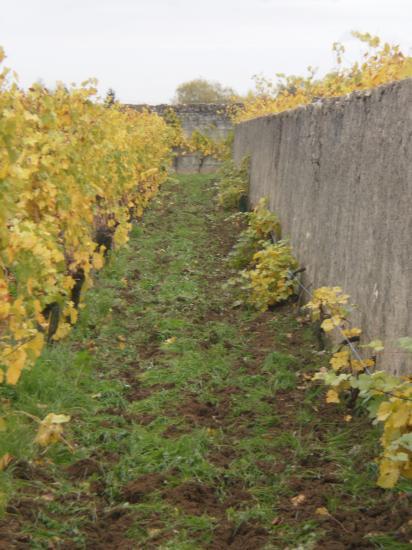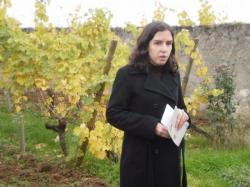Le vignoble saumurois
C'est Céline qui débutait la journée, avec la présentation dans le bus, et sur le terrain, du vignoble saumurois. 
 The vineyards are situated in a triangle formed by the Loire, its tributary the Thouet and the forest of Fontevraud. The appellation begins on the limestone hills overlooking the Loire.
The vineyards are situated in a triangle formed by the Loire, its tributary the Thouet and the forest of Fontevraud. The appellation begins on the limestone hills overlooking the Loire.
The soil is made of limestone called tuffa. It has the peculiarity of storing the winter rains to release them slowly during the dry months. So, the vine gets a slow regular flow of water vital to the grapes maturation. This stone also store heat by day and diffuse it by night. That’s why the famous red wine of Saumur is called Champigny which comes from the latin “Campus Ignis” and means Fields of Fire.
In the Saumur vineyards, there are different kinds of wines :
- Saumur d’origine : sparkling wine with natural bubbles. In 1811, Jack Ackermann discover how to control the effervescence of sparkling wines. This wine has the same properties that the Champagne wine.
- Saumur Champigny : the most famous red wine in the Saumur region. It’s made in great majority from the Cabernet franc grape variety but other grape varieties are permitted such as the Cabernet Sauvignon and the Pineau d’Aunis
- Cabernet d’Anjou : wine making into rose wine from Cabernet franc (red wine). There are two ways to make a rose wine :
o Use the grapes less red from grapes usually used to make red wine
o Make a mix of red and white wines
History :
It was the monks of the Fontevraud’s abbey, who first developed the culture of the vine in the Saumur region.
In 1154, Henri the 2nd Plantagenet, who was the earl of Anjou, became king of England. At this time, the demand in Anjou wines strongly increased thanks to the English aristocracy. During all the Middle Ages, the influence of the Dukes of Anjou gave rise to a considerable growth in wine production.
In the 17th century, the region was replanting with Cabernet, which came from Guyenne (Aquitaine) by boat and passed by Nantes, an important city of Britain. As a result, the variety become known locally as the “Breton” wine until the arrival of Père Cristal in 1886.
Clos between the walls :
Antoine Cristal was an experimental and innovative wine producer. Many of his ideas were put into practice here at the Clos between the walls, now property of the Château de Parnay.
Here, walls were built to capture and store the heat and warm the vines to improve ripening. In the North side, he planted vine stocks and, by a hole in the walls, the vines are exposed in the south side. Mister Cristal used to say : “Feet in the shade, bellies in the sun”. He made the Saumur wines famous outside the region.
Mushrooms beds :
You can see some kind of chimneys. It’s because we produce mushrooms here in holes in the rock called troglodytes (Vanessa will speak about this later). And what you see here, it’s a chimney built to bring some air in the mushrooms beds. It’s kind hard to imagine that, under the vines, people are cultivating mushrooms in holes in the rock !
Vocabulary :
Ne pas confondre: Vine (= vigne) et wine (=vin)
Ripening : maturation
Vine stocks : ceps de vigne
Mushrooms beds : champignonière





